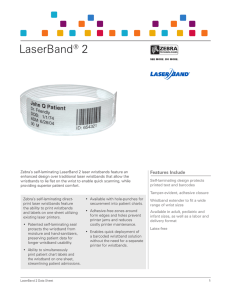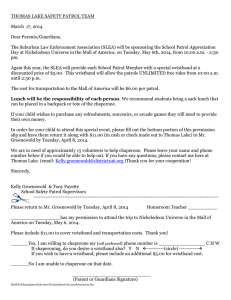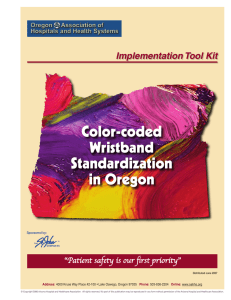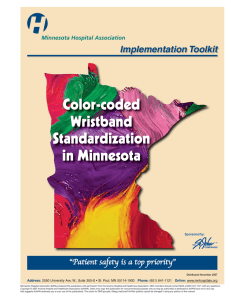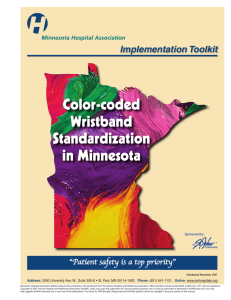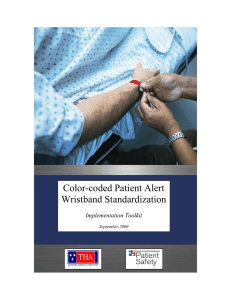Silicone Wristbands as Personal Monitoring Devices Supporting Information
advertisement
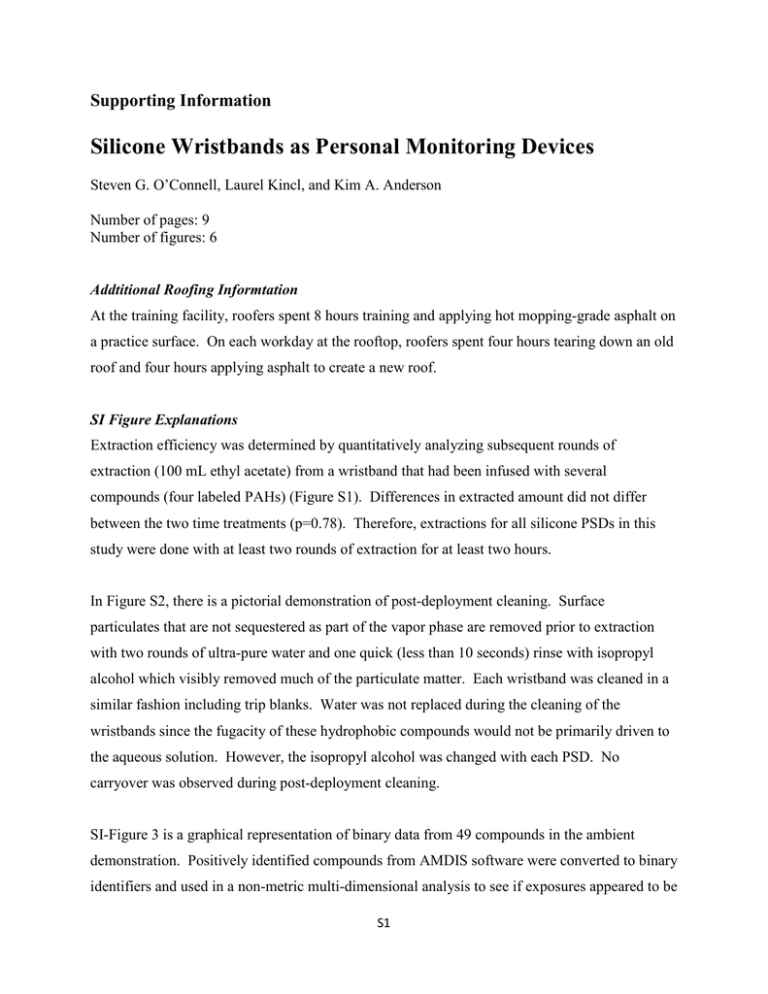
Supporting Information Silicone Wristbands as Personal Monitoring Devices Steven G. O’Connell, Laurel Kincl, and Kim A. Anderson Number of pages: 9 Number of figures: 6 Addtitional Roofing Informtation At the training facility, roofers spent 8 hours training and applying hot mopping-grade asphalt on a practice surface. On each workday at the rooftop, roofers spent four hours tearing down an old roof and four hours applying asphalt to create a new roof. SI Figure Explanations Extraction efficiency was determined by quantitatively analyzing subsequent rounds of extraction (100 mL ethyl acetate) from a wristband that had been infused with several compounds (four labeled PAHs) (Figure S1). Differences in extracted amount did not differ between the two time treatments (p=0.78). Therefore, extractions for all silicone PSDs in this study were done with at least two rounds of extraction for at least two hours. In Figure S2, there is a pictorial demonstration of post-deployment cleaning. Surface particulates that are not sequestered as part of the vapor phase are removed prior to extraction with two rounds of ultra-pure water and one quick (less than 10 seconds) rinse with isopropyl alcohol which visibly removed much of the particulate matter. Each wristband was cleaned in a similar fashion including trip blanks. Water was not replaced during the cleaning of the wristbands since the fugacity of these hydrophobic compounds would not be primarily driven to the aqueous solution. However, the isopropyl alcohol was changed with each PSD. No carryover was observed during post-deployment cleaning. SI-Figure 3 is a graphical representation of binary data from 49 compounds in the ambient demonstration. Positively identified compounds from AMDIS software were converted to binary identifiers and used in a non-metric multi-dimensional analysis to see if exposures appeared to be S1 unique among individuals, or if all wristbands sequestered the same number and type of compounds. Several wristbands were worn by the same individual (optional choice by the participant), and are circled (graphical representation only) on Figure S3. Although it is difficult to ascertain much from the data, it does appear that some exposures were more unique than others based on spatial differences on the graph (example: device #8 vs device #2). The total ion chromatogram of devices 13.1 and 13.2 had particularly high amounts of peaks that likely resulted from skin contact. Interferences from either month-long skin contact or an earlier cleaning process could at least partially explain poor resolution of partnered devices on the graph. Figure S4 shows the concentration remaining in wristbands (n=4) that were infused with 5 PAHs of varied physicochemistry and exposed for four hours in either direct sunlight or exposed in shade. The four hour exposure took place in September, 2013 between 11:30am - 3:30 pm on a clear day in Corvallis, Oregon. Silicone PSDs were placed on pre-rinsed foil on either an exposed aluminum 3 m rooftop, or underneath the roof between support beams. Distance between each set of samples was less than 2 meters, and shade exposed samples were protected from sunlight from above and below, but not from the sides so that air flow may be similar between each group. Data loggers (Onset Computer Corp., Bourne, MA) were used to log changes in temperature throughout the exposure. Temperature differences between each group were nearly 8 degrees centigrade (shade – 22.6 °C; sun – 30.4 °C), but no differences were observed between any group for any compound (Figure S4). Figure S5 shows a comparison of three temperatures in simulated transport conditions. Silicone passive samplers were placed in PTFE bags for 72 hours, at -20 °C (walk-in freezer), ~23°C (ambient) and 35 °C (drying oven). Temperatures were monitored every 30 minutes from temperature loggers. The PSD had been infused with 5 PAHS as discussed above. Ratios of each analyte response divided by the internal standard response are reported in Figure S5 since an error with surrogate recovery artificially inflated variance across treatments. While fluorene does appear to have significantly different response ratios across all three temperature treatments (one-way ANOVA, p = 0.03), pairwise comparisons with the Holm-Sidak method does not report significant changes between any two treatment groups. Ultimately, the largest change S2 among all analytes was still less than 13 % (fluorine-d10 – freezer and ambient treatments), so any changes in PAH concentrations were deemed negligible. Furthermore, potential changes in concentration would have been conserved since transportation was similar among PSDs within each pilot study or demonstration. Silicone PSDs from the training exercise were pooled among each configuration (Figure S6) to test whether devices differed from participant exposure (p=0.09). Although there are not any significant differences between devices, much of the variance listed here might stem from partially covered PSDs from protective clothing as described in the manuscript. Further evidence is needed to ascertain whether clothing does reduce air flow, and therefore changes the micro-environment of exposure around the silicone PSD. S3 Figure S1. Average (n=3) relative contributions of subsequent extractions under two extraction time treatments using ethyl acetate for four labeled PAHs. Each round consisted of either 2 or 24 hours for a total of 6 or 72 hours respectively. S4 Figure S2. Photographic demonstration of post-deployment cleaning before and afterwards. A) Stacked wristband configuration prior to surface cleaning. Particulates are present on the surface of the wristband. B) Top wristband after post-deployment cleaning. Surface particulates are no longer visible, and wristband is ready for extraction. The extra-wide bottom wristband was discarded. S5 Figure S3. A graphical representation of non-metric multidimensional scaling of binary ambient wristband data. Ellipses encompass wristbands obtained by the same participant. S6 Figure S4. Four hour exposure of PAH infused wristbands exposed in either full sunlight or in shade. No significant difference was seen between either exposure despite sunlight exposure and resulting temperature differences greater than 8°C. Standard deviations are the result of four replicates. Abbreviations: Benzo[b]fluoranthene (B[b]FLA). S7 3.5 -20°C (n=3) 3 Response Ratio 23°C (n=3) 2.5 35°C (n=3) 2 1.5 1 0.5 0 Fluorene-D10 B[b]FLA-D12 Fluorene Pyrene B[b]FLA Figure S5. A 72 hour simulated transport study PAH infused wristbands in PTFE bags stored at three different temperatures. No substantial losses of compounds were seen with higher transport temperatures. Amounts here are the response ratio of the analyte over the internal standard peryleneD12. Standard deviations are the result of three replicates. Abbreviations: Benzo[b]fluoranthene (B[b]FLA). S8 Figure S6. Eight hour training PSD exposure. No significant difference was found between devices from occupational exposure. S9




